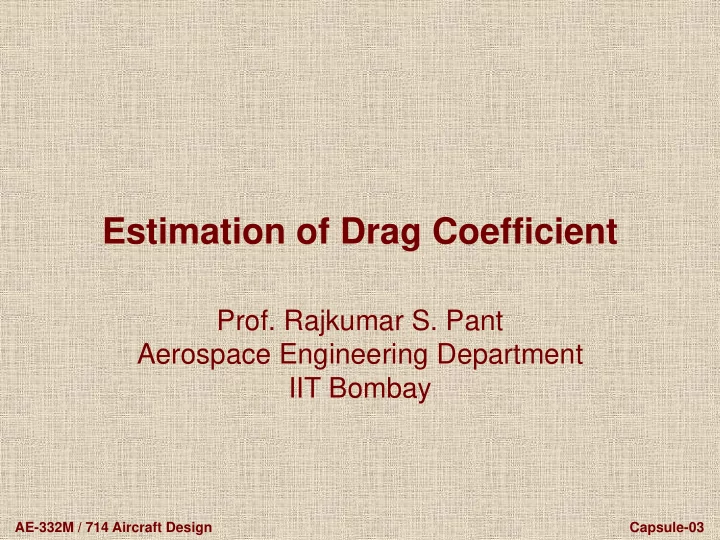

Estimation of Drag Coefficient Prof. Rajkumar S. Pant Aerospace Engineering Department IIT Bombay AE-332M / 714 Aircraft Design Capsule-03
Mostly applicable to Transport Aircraft SUBSONIC PARASITE DRAG COEFFICIENT ESTIMATION AE-332M / 714 Aircraft Design Capsule-03
Subsonic Parasite Drag Components Drag Parasite Induced Subsonic (PROFILE) Skin Friction Form Interference Others Misc. Leak. & Prot. AE-332M / 714 Aircraft Design Capsule-03
Two Approaches Equivalent Skin Friction Component Buildup D total = ∑ D comp + D L&P + D misc. D Parasite = D SF + D press = 90% + 10% D comp. = D SF + D Form +D Interference = D SF + x(D SF ) D SF = C f * S wet /S ref C fe = Eq. Skin Friction Coeff. D Form = FF*D SF C Do = C fe *(S wet /S ref ) D interference = Q * D SF D misc. = Drag of Misc. Items C fe * 10 -4 Aircraft type o Flaps High Speed Aircraft 25 o Unretracted Landing Gear Bomber & Transport 30 o Upsweft Aft Fuselage Military Cargo 35 o Fuselage Base area Airforce Fighter 35 D L&P = Drag due to Naval Fighter 40 o Leakages G.A. Twin Engined 45 o Protuberances G.A. Single Engined 55 Propeller Sea Plane 60 AE-332M / 714 Aircraft Design Capsule-03
Component Buildup Method C F,c = Flat-plate skin-friction drag coefficient for component c FF c = Form factor for component c Q c = Interference factor for component c S wet,c = Wetted area for component c S ref = Reference area C D,misc = Drag coefficient due to miscellaneous factors C D,L&P = Drag Coefficient for Leakages & Protuberances AE-332M / 714 Aircraft Design Capsule-03
Flat Plate Skin Friction Coefficient C f depends on Re, M & k (surface roughness) Strong function of extent of Laminar Flow Re > ½ million :Difficult to maintain laminar flow Re = 1 million :Turbulent SFD = 3 x Laminar SFC o Very smooth skin (molded composite or polished metal) • Typically, over 15-20 % of wing & tails, none over fuselage AE-332M / 714 Aircraft Design Capsule-03
Determination of C f C f v/s Reynold's No. and Mach No. in Turbulent & Laminar Flow for very smooth surfaces 0.009 Laminar 0.008 0.5 million Skin Friction Coefficient 0.007 1.00 million 1.25 million 0.006 0.005 0.004 0.003 C f = 1.328 / (Re) 0.5 0.002 0.001 0 0.0 0.2 0.4 0.6 0.8 1.0 1.2 1.4 1.6 1.8 2.0 Millions Reynold's Number AE-332M / 714 Aircraft Design Capsule-03
Piaggio P-180 Avanti Twin turboprop executive transport Three Surface Aircraft V max 400 kt, V cr 350 kt Laminar Flow over 50% of wing & tail and 35 % of fuselage NLF wing designed by Ohio University AE-332M / 714 Aircraft Design Capsule-03
Effect of surface roughness Roughness leads to higher C f Re cutoff used for skin roughness effect Re cutoff = 38.21 (l/k) 1.053 If M < 0.75 : Re cutoff = 44.62 (l/k) 1.053 . M 1.16 Else : Re = min(Re cutoff , Re actual ) in Turbulent Flow l = Characteristic Length Surface k (mm) Camouflage paint on Aluminum 0.1015 Smooth Paint 0.0634 Production Sheet metal 0.0405 Polished Sheet metal 0.0152 Smooth molded composite 0.0052 AE-332M / 714 Aircraft Design Capsule-03
Estimation of Form Factors For Nacelle & smooth External store FF = 1.0+(0.35/f) f = l/d (x/c) m = chordwise location of max. thickness = 0.3 for low speed aerofoil = 0.5 for high speed aerofoil Λ m = sweep of maximum thickness line Pressure Drag due to viscous separation Note: Formulae not valid beyond M DD AE-332M / 714 Aircraft Design Capsule-03
Interference Factor (Q) Measure of increased drag due to interference between components External store mounted near fuselage has high Q compared to wing-tip mounted missile Typical Values of Q Fuselage = 1.00 V- Tail = 1.03 Conv. Tail = 1.05 H-Tail = 1.08 AE-332M / 714 Aircraft Design Capsule-03
Q factors Nacelle & Store mounting Function of o Distance of store from fuselage (l) vis-à-vis Fuselage dia (d fus ) l = 0 (mounted directly on Fuselage) Q = 1.5 l < d fus , Q =1.3 l > d fus , Q = 1.0 Q = 1.25 for wing-tip mounted missiles Wing Location For high / mid wing, or well filleted low wing, Q = 1.0 For unfilleted low wing, Q = 1.1 to 1.4 AE-332M / 714 Aircraft Design Capsule-03
Leakage & Protuberance Drag Leakage Tendency to “inhale/exhale air through holes” Protuberances Antennae, lights, door edges, fuel vents, protruding rivets,.. Estimated as a % of total parasite drag coefficient. Bombers 02-05 % Propeller a/c 05-10 % Fighters 10-15 % AE-332M / 714 Aircraft Design Capsule-03
Concept of Drag Area Drag Area = DA = C D . S Since D = q S C D hence DA = D/q Usually, S = S ref C Do misc = DA / Wing reference area Thus, DA is an Indication of Drag Coefficient Very common in automobile aerodynamics S REF = Frontal Area DA of a bicycle = 0.6 to 0.7 m 2 AE-332M / 714 Aircraft Design Capsule-03
DA of some cars Drag Area (m 2 ) Model Name Volkswagen XL1 0.279 Honda Insight 0.474 Hummer H2 2.46 Source: http://en.wikipedia.org/wiki/Automobile_drag_coefficient#Drag_area AE-332M / 714 Aircraft Design Capsule-03
Miscellaneous Drag Store Drag using empirical relationships for D/q v/s M Landing Gear Drag Comparison with test data Component build up, 20% extra for interference 7% additional drag for open gear wells Fuselage Upsweep Drag D/q (upsweep) = 3.83u 2.5 A max , u in radians u A max AE-332M / 714 Aircraft Design Capsule-03
Recommend
More recommend